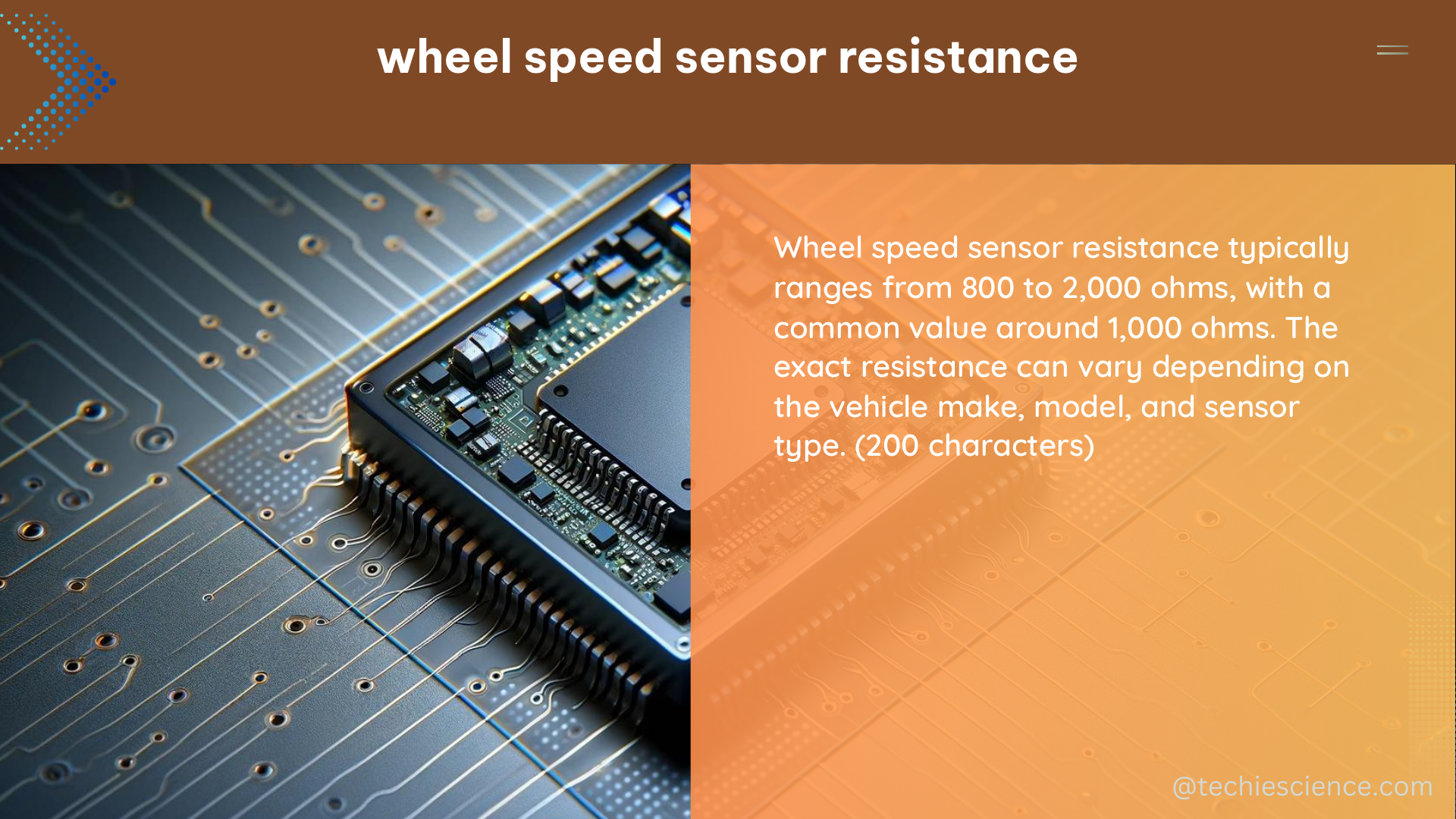The wheel speed sensor resistance is a crucial parameter in the proper functioning of the Anti-lock Braking System (ABS) in vehicles. The resistance of the wheel speed sensor should be within a specific range for the ABS system to work correctly. This comprehensive guide will provide you with detailed information on the technical specifications, testing procedures, and troubleshooting tips for wheel speed sensor resistance.
Understanding Wheel Speed Sensor Resistance
The wheel speed sensor is a critical component of the ABS system, responsible for monitoring the rotational speed of each wheel. The resistance of the wheel speed sensor is a measure of the electrical resistance between the two terminal pins of the sensor. This resistance value is essential for the ABS control module to accurately interpret the wheel speed data and function properly.
According to the WABCO ABS Sensor Tests – Technical Bulletin, the resistance of the wheel speed sensor should be within the following range:
- Resistance between the terminal pins: 900-2000 ohms
- Resistance from each terminal pin to the sensor case or a good vehicle ground: Infinite (open circuit)
It’s important to note that the resistance values may vary slightly depending on the specific make and model of the vehicle, so it’s always best to refer to the manufacturer’s specifications.
Measuring Wheel Speed Sensor Resistance

To measure the wheel speed sensor resistance, you’ll need to use a digital multimeter (Volt-Ohm meter) and follow these steps:
- Ensure the vehicle is parked on a level surface, the parking brake is applied, and the ignition is turned off.
- Locate the wheel speed sensor connector, which is typically located near the wheel hub or suspension component.
- Disconnect the wheel speed sensor connector and identify the terminal pins.
- Set your multimeter to the resistance (ohms) measurement function.
- Measure the resistance between the two terminal pins of the wheel speed sensor. The reading should be between 900-2000 ohms.
- Measure the resistance from each terminal pin to the sensor case or a good vehicle ground. The reading should be infinite (open circuit).
If the resistance values are outside the specified range, it could indicate a problem with the wheel speed sensor or the wiring harness. In such cases, further investigation and troubleshooting may be required.
Factors Affecting Wheel Speed Sensor Resistance
Several factors can influence the wheel speed sensor resistance, including:
- Sensor Condition: A worn, damaged, or contaminated wheel speed sensor can cause the resistance to be outside the specified range.
- Wiring Harness: Issues with the wiring harness, such as shorts, opens, or corrosion, can affect the resistance measurements.
- Temperature: Extreme temperatures, both hot and cold, can impact the resistance values.
- Sensor Alignment: Improper installation or misalignment of the wheel speed sensor can lead to resistance problems.
It’s essential to consider these factors when troubleshooting wheel speed sensor resistance issues.
Troubleshooting Wheel Speed Sensor Resistance
If the wheel speed sensor resistance is outside the specified range, follow these troubleshooting steps:
- Inspect the Sensor: Visually inspect the wheel speed sensor for any signs of damage, contamination, or wear. Replace the sensor if necessary.
- Check the Wiring Harness: Inspect the wiring harness for any signs of damage, such as cuts, abrasions, or corrosion. Test the continuity and resistance of the wiring to ensure proper connectivity.
- Verify Sensor Alignment: Ensure the wheel speed sensor is properly installed and aligned with the tone ring or reluctor wheel. Adjust the sensor position if necessary.
- Perform a Voltage Test: Measure the sensor’s output voltage while the wheel is spinning. The voltage should be within the manufacturer’s specifications.
- Replace the Sensor: If the resistance and voltage tests indicate a faulty sensor, replace the wheel speed sensor with a new one.
Remember to always refer to the manufacturer’s service manual for specific testing procedures and troubleshooting guidelines.
Conclusion
The wheel speed sensor resistance is a critical parameter in the proper functioning of the ABS system. By understanding the technical specifications, testing procedures, and troubleshooting steps, you can effectively diagnose and address any issues related to wheel speed sensor resistance. This comprehensive guide should provide you with the necessary knowledge to maintain and repair your vehicle’s ABS system effectively.
References
- WABCO ABS Sensor Tests – Technical Bulletin, https://www.zf.com/products/media/automotive/cv/literature_downloads_wna/truck_solutions/abs__ebs___habs_technical_publications/TP99145_web.pdf
- Testing ABS Wheel Sensors – iRV2 Forums, https://www.irv2.com/forums/f22/testing-abs-wheel-sensors-400349.html
- (’03-’05) – Rear ABS Wheel Speed Sensor measuring questing, https://www.subaruforester.org/threads/rear-abs-wheel-speed-sensor-measuring-questing.294001/
- ABS wheel speed sensor (MRE) – Pico Automotive, https://www.picoauto.com/library/automotive-guided-tests/mre-wheel-speed-sensor
- How to test wheel sensor to see if it’s faulty? – Impala Forums, https://www.impalaforums.com/threads/how-to-test-wheel-sensor-to-see-if-its-faulty.330933/

The lambdageeks.com Core SME Team is a group of experienced subject matter experts from diverse scientific and technical fields including Physics, Chemistry, Technology,Electronics & Electrical Engineering, Automotive, Mechanical Engineering. Our team collaborates to create high-quality, well-researched articles on a wide range of science and technology topics for the lambdageeks.com website.
All Our Senior SME are having more than 7 Years of experience in the respective fields . They are either Working Industry Professionals or assocaited With different Universities. Refer Our Authors Page to get to know About our Core SMEs.